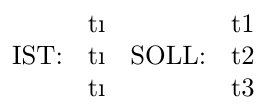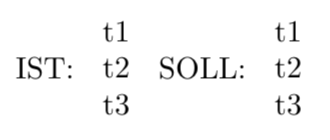|
Kann man dieses Beispiel so umgestalten, dass auch die Laufvariable Etwa
funktioniert nicht. Oder geht das nur mit größeren Maßnahmen wie z.B. etoolbox? \documentclass[margin=2mm]{standalone} \usepackage{tikz} \newcommand{\test}[1]{% \def\temp{}% \foreach \i in {1,...,#1} {% \expandafter\gdef\expandafter\temp\expandafter{\temp t\i \\}% }% \temp} \begin{document} IST: \begin{tabular}{c} \test{3} \end{tabular} SOLL: \begin{tabular}{c} t1 \\ t2 \\ t3 \\ \end{tabular} \end{document} |
|
Während Murmeltier's Antwort bereits eine pragmatische Lösung zeigt, sei im folgenden noch ein wenig erklärt, was die Problematik ist und wie man diese möglichst allgemein lösen kann. Das Problem mit dem gezeigten Code ist, dass zwar die Definition von \documentclass[margin=2mm]{standalone} \usepackage{tikz} \newcommand{\test}[1]{% \def\temp{}% \foreach \i in {1,...,#1} {% \expandafter\expandafter\expandafter\gdef\expandafter\expandafter\expandafter\temp\expandafter\expandafter\expandafter{\expandafter\temp \expandafter t\i \\}% }% \temp} \begin{document} IST: \begin{tabular}{c} \test{3} \end{tabular} SOLL: \begin{tabular}{c} t1 \\ t2 \\ t3 \\ \end{tabular} \end{document} Hier wird durch die zusätzlichen \documentclass[margin=2mm]{standalone} \usepackage{tikz} \newcommand{\test}[1]{% \def\temp{}% \foreach \i in {1,...,#1} {% \xdef\temp{\unexpanded\expandafter{\temp t}\i\unexpanded{\\}}% }% \temp} \begin{document} IST: \begin{tabular}{c} \test{3} \end{tabular} SOLL: \begin{tabular}{c} t1 \\ t2 \\ t3 \\ \end{tabular} \end{document} greifen. \documentclass[margin=2mm]{standalone} \usepackage{tikz} \makeatletter \newcommand{\test}[1]{% \def\temp{}% \foreach \i in {1,...,#1} {% \protected@xdef\temp{\temp t\i\protect\\}% }% \temp} \makeatother \begin{document} IST: \begin{tabular}{c} \test{3} \end{tabular} SOLL: \begin{tabular}{c} t1 \\ t2 \\ t3 \\ \end{tabular} \end{document} Hier wird das Besser wäre übrigens, \documentclass[margin=2mm]{standalone} \usepackage{tikz} \newcommand{\test}[1]{% \def\temp{\begin{tabular}{c}}% \foreach \i in {1,...,#1} {% \xdef\temp{\unexpanded\expandafter{\temp t}\i\unexpanded{\\}}% }% \expandafter\def\expandafter\temp\expandafter{\temp\end{tabular}}% \temp} \begin{document} IST: \test{3} SOLL: \begin{tabular}{c} t1 \\ t2 \\ t3 \\ \end{tabular} \end{document} vorschlagen. Wenn Du sehen willst, was Stück für Stück innerhalb von \documentclass[margin=2mm]{standalone} \usepackage{tikz} \newcommand{\test}[1]{% \def\temp{\begin{tabular}{c}}% \show\temp \foreach \i in {1,...,#1} {% \xdef\temp{\unexpanded\expandafter{\temp t}\i\unexpanded{\\}}% \show\temp }% \expandafter\def\expandafter\temp\expandafter{\temp\end{tabular}}% \show\temp \temp} \begin{document} IST: \test{3} SOLL: \begin{tabular}{c} t1 \\ t2 \\ t3 \\ \end{tabular} \end{document} verwenden, um in der > \temp=macro: ->\begin {tabular}{c}. \test ...f \temp {\begin {tabular}{c}}\show \temp \foreach \i in {1,...,#1} ... l.17 IST: \test{3} > \temp=macro: ->\begin {tabular}{c}t1\\. \pgffor@body ...t}\i \unexpanded {\\}}\show \temp l.17 IST: \test{3} > \temp=macro: ->\begin {tabular}{c}t1\\t2\\. \pgffor@body ...t}\i \unexpanded {\\}}\show \temp l.17 IST: \test{3} > \temp=macro: ->\begin {tabular}{c}t1\\t2\\t3\\. \pgffor@body ...t}\i \unexpanded {\\}}\show \temp l.17 IST: \test{3} > \temp=macro: ->\begin {tabular}{c}t1\\t2\\t3\\\end {tabular}. \test ...dafter {\temp \end {tabular}}\show \temp \temp l.17 IST: \test{3} zu erhalten. Achtung: Im Online-Editor Overleaf funktioniert das so nicht, da Danke für die ausführliche Abhandlung.
(05 Jun '18, 22:54)
cis
|
|
Meine obligatorische Lua-Lösung darf natürlich nicht fehlen. :) \documentclass{article} \usepackage{tikz} \newcommand{\test}[1]{% \directlua{ for i = 1,#1 do tex.sprint("t" .. i .. [[\noexpand\\]]) end }% } \begin{document} IST: \begin{tabular}{c} \test{3} \end{tabular} SOLL: \begin{tabular}{c} t1 \\ t2 \\ t3 \\ \end{tabular} \end{document} |
\documentclass[margin=2mm]{standalone} \usepackage{tikz} \newcommand{\test}[1]{% \xdef\temp{}% \foreach \i in {1,...,#1} {% \xdef\temp{\temp t\i \cr}% }% \temp} \begin{document} IST: \begin{tabular}{c} \test{3} \end{tabular} SOLL: \begin{tabular}{c} t1 \\ t2 \\ t3 \\ \end{tabular} \end{document} 1
Hinweis: Das funktioniert so natürlich nur, solange wirklich komplett expandiert werden soll! In LaTeX ist es meist besser,
(04 Jun '18, 08:31)
saputello
|


